Integration with Azure DevOps
This page describes how to set up both Allure TestOps and Azure DevOps in a project that uses Azure Pipelines to run tests.
Like all other CI integrations for Allure TestOps, this involves communication in two directions:
- A job in an Azure pipeline uses allurectl to send its status and test results to Allure TestOps.
- Allure TestOps uses Azure DevOps API to trigger new pipelines, optionally passing a test plan.
Once a pipeline run stops, the corresponding launch in Allure TestOps may be closed either manually or automatically, according to the auto-close policy settings.
To add Allure TestOps support in your Azure DevOps pipeline:
- Enable sending data from Azure DevOps.
- Enable triggering Azure pipelines.
- Parametrize jobs (if necessary).
1. Enable sending data from Azure DevOps
For Azure DevOps to send pipeline statuses and test results to Allure TestOps, you need to generate an authentication token in Allure TestOps, add the token to Azure DevOps, and modify the pipeline itself.
Then, run and check the pipeline to make sure that everything works so far.
1.1. Create a token in Allure TestOps
In Allure TestOps, click your avatar and go to API Tokens.
Click + Token.
Enter a name for the token (e.g., "Token for Azure DevOps") and click Create.
Allure TestOps will generate the token and display it in a modal window.
Click the Copy icon to copy the token into clipboard. You will need this token in the next step.
1.2. Specify the token in Azure DevOps
In Azure DevOps, go to Pipelines and select the pipeline you need.
In the top right corner, click Edit.
In the top right, click the Variables button.
Click New variable or +. In the dialog that appears, fill in the fields:
- Name — “ALLURE_TOKEN”.
- Value — the API token that you got on step 1.1.
- Keep this value secret — must be checked.
- Let users override this value when running this pipeline — must not be checked.
Click OK.
Click + again. In the dialog that appears, fill in the fields:
- Name — “ALLURE_JOB_RUN_ID”.
- Value — must be blank.
- Keep this value secret — must not be checked.
- Let users override this value when running this pipeline — must be checked.
Click OK.
Click Save to apply the changes and close the dialog.
1.3. Modify the pipeline
Make the following changes in the azure-pipelines.yml file in your repository. You can do it either in a local directory or in the Azure's web-based text editor.
At the beginning of the
stepssection, add a new step that downloads the allurectl tool and makes it executable.In the step that runs tests, add or extend the
envblock. It must include the following variables:ALLURE_ENDPOINT— the URL of the Allure TestOps instance.ALLURE_PROJECT_ID— the ID of the Allure TestOps project.ALLURE_RESULTS— the path to the test results directory, e.g., “build/allure-results”. If there are multiple test result directories in your project, you can separate them with commas or use a wildcard pattern, e.g., “modules/*/build/allure-results”.ALLURE_TOKEN—$(ALLURE_TOKEN).
Wrap the command that runs the tests into the
./allurectl watchcommand.
Example
Assume we have a Java project with a azure-pipelines.yml file like this:
steps: - script: ./gradlew clean test displayName: Run testsWith Allure TestOps integration, the file will look something like this:
steps: - bash: curl -fsSL https://github.com/allure-framework/allurectl/releases/latest/download/allurectl_linux_amd64 -o allurectl && chmod +x allurectl displayName: Download allurectl - script: ./allurectl watch -- ./gradlew clean test displayName: Run tests env: ALLURE_ENDPOINT: https://testops.example.com ALLURE_PROJECT_ID: 1 ALLURE_RESULTS: build/allure-results ALLURE_TOKEN: $(ALLURE_TOKEN)
1.4. Run and check the pipeline
In Azure DevOps, open the project and go to the pipeline run triggered by the latest commit.
Alternatively, you can trigger a new pipeline run manually.
If the pipeline run is not yet finished, wait until it finishes.
In the pipeline run details, click the job that runs tests.
Close to the end of its log, there should be a link to the test report at Allure TestOps. Make sure that it is present and works.
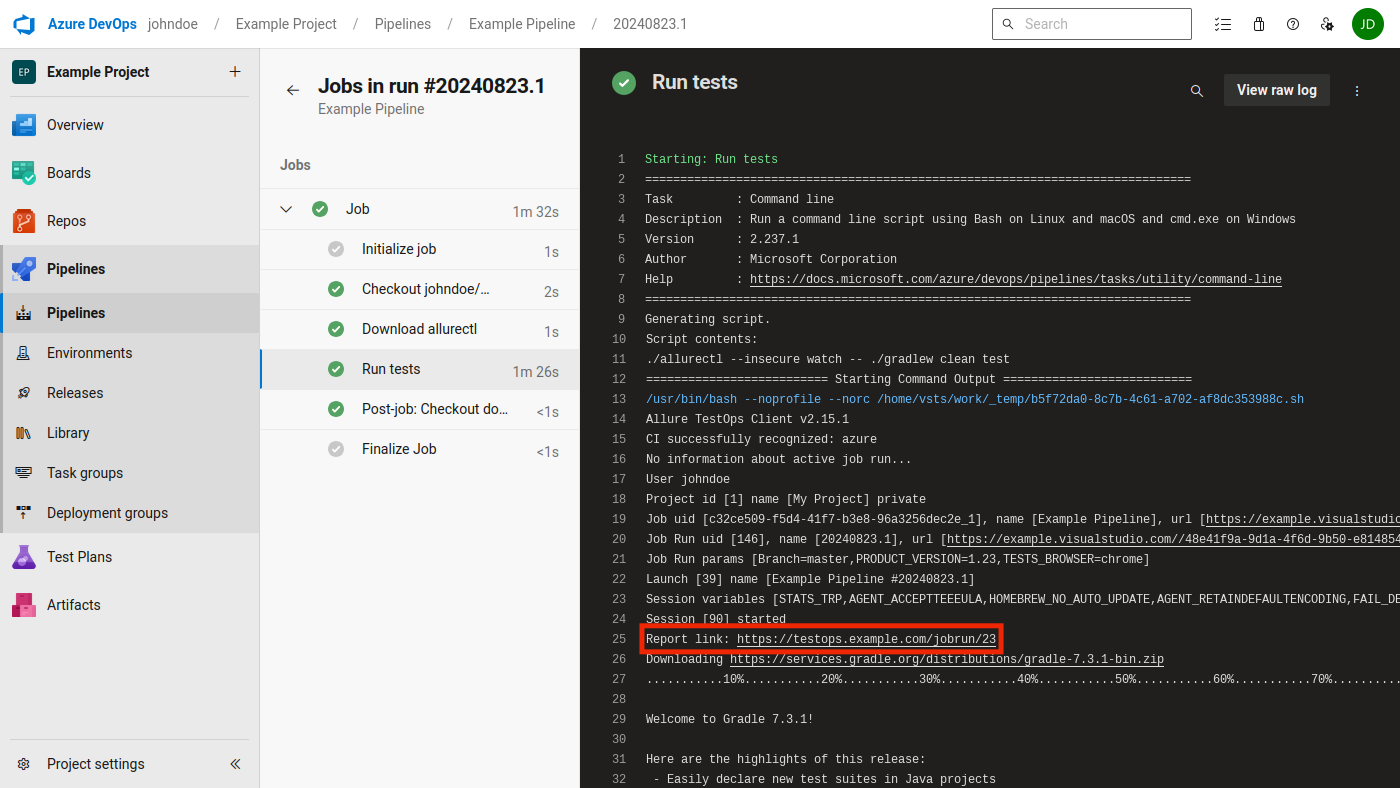
In the Allure TestOps launch, open a single test result.
At the bottom of the page, there should be a link back to the Azure pipeline. Make sure that it is present and works.
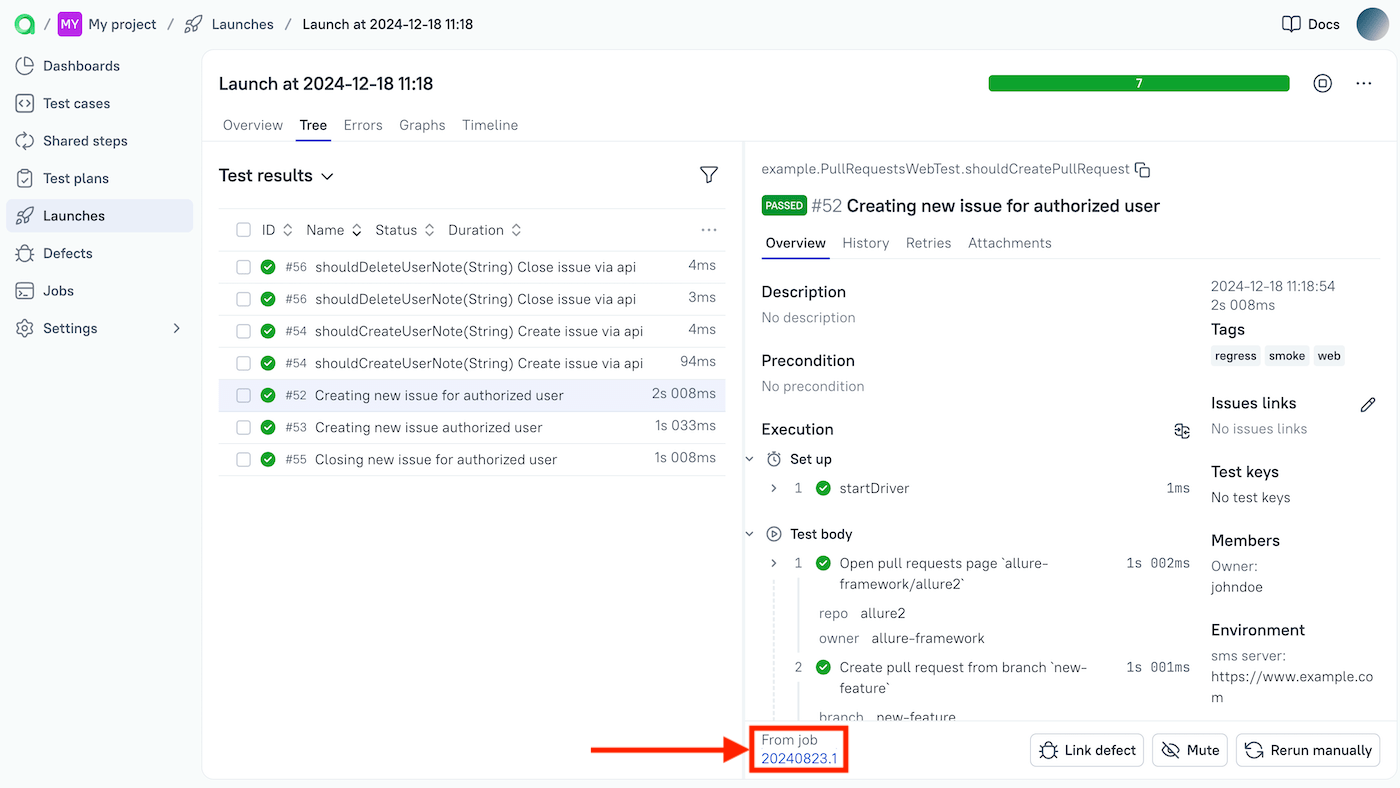
2. Enable triggering Azure pipelines
On the Allure TestOps side, the integration with Azure DevOps needs to be configured on two levels.
First, the administrator needs to specify the Azure DevOps URL.
Then, any project owner needs to create an authentication token in Azure devOps, add it to Allure TestOps, and configure the job in Allure TestOps.
2.1. Specify Azure DevOps URL in Allure TestOps
Log into Allure TestOps using an administrator account.
Go to Administration → Integrations.
Click + Add integration in the top right corner of the screen.
In the dialog that appears, select Azure DevOps Server.
Fill in the fields:
- Name — a name to help you recognize the integration, e.g., “Azure DevOps production”.
- Endpoint — the URL of the Azure DevOps organization, e.g., “https://dev.azure.com/my-organization/”.
Click Add integration.
2.2. Create a token in Azure DevOps
In Azure DevOps, click the User settings icon next to your avatar and select Personal access tokens.
Click New Token.
In the dialog that appears, fill in the fields:
- Name — a name to help you recognize the token, e.g., “Token for Allure TestOps”.
- Organization — the Azure DevOps organization that contains the project you want to integrate with Allure TestOps.
- Expiration — how long the token must stay valid. After this date, the integration will stop working, and you will need to create a new token to continue using the integration.
- Scopes — “Custom defined”.
At the bottom of the dialog, click Show all scopes.
Select the following scopes:
- Build → Read & execute
- Work Items → Read, write, & manage
- Variable Groups → Read
Click Create.
The new token will become temporarily visible. Copy it, you will need this token on the next step.
2.3. Add the token to an Allure TestOps project
In Allure TestOps, open your project.
Go to Settings → Integrations.
Under the Available integrations, find the Azure DevOps integration and click Add integration next to it.
In the dialog that appears, fill in the fields:
- Username (email) — the email that you use to log into Azure DevOps.
- API token — the API token that you got on step 2.2.
Click Test connection. If the credentials are correct, a "Connection established" message will appear within a few seconds.
Click Add integration to save the settings.
2.4. Configure the job in Allure TestOps
In Allure TestOps, open your project.
Go to Jobs.
The page should contain a new job automatically added and configured during the launch on step 1.4.
Click
⋯next to the job name, then select Configure.In the dialog that appears, edit the fields:
- Name — a name to help you recognize the job.
- Build server — the name of the integration that you added on step 2.1.
- Job can be used to run tests — if checked, users will be able to trigger this job from Allure TestOps.
- Parameters — parameters that should be passed to Azure DevOps via environment variables, see Environment.
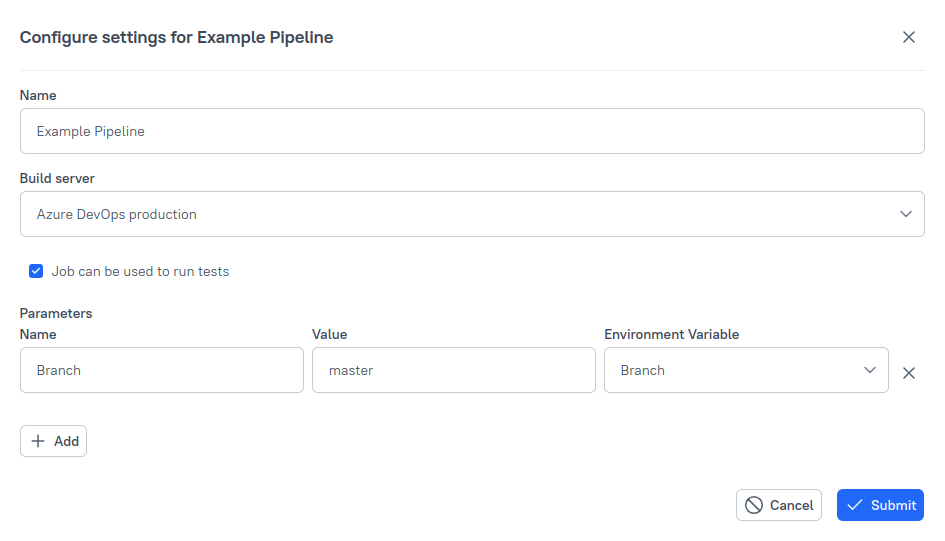
Click Submit.
3. Parametrize jobs
Azure pipeline runs can accept variables. Allure TestOps integrates this feature with its own Environment concept, which lets you both set parameters for new jobs and see parameters set for jobs that were started outside Allure TestOps.
First, the administrator needs to declare the required display names for parameters globally.
Then, any project owner needs to configure the parameters mapping in the project settings and in the job settings in Allure TestOps.
Finally, the variables must be also added to the pipeline in Azure DevOps.
If your project's repository has multiple branches, make sure to create a Branch environment variable in Allure TestOps and pass it to your job. This special name will instruct Azure DevOps which of the branches it should use.
3.1. Add global parameter names
Log into Allure TestOps using an administrator account.
Go to Administration → Environment.
For each parameter name that you want to add:
Click + Create.
Enter the name of the new parameter.
Click Submit.
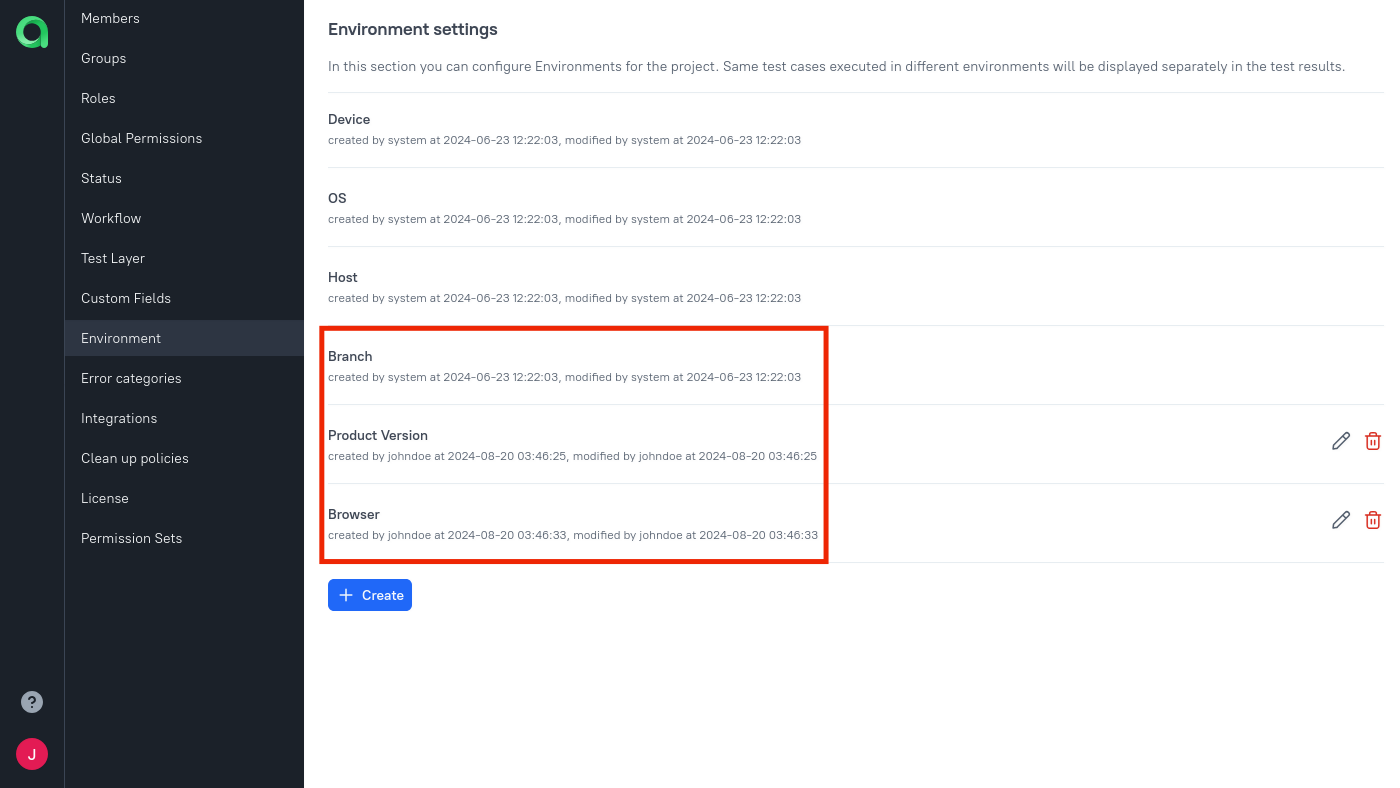
3.2. Map parameters to environment variables
In Allure TestOps, open your project.
Go to Settings → Environment.
For each parameter name that you want to use:
Click + Create if the parameter is not in the list. Otherwise, click the Edit icon next to its name.
In the Mapping key field, specify the name of the environment variable.
In the Environment variable field, select the global parameter name from step 3.1.
Click Submit.

3.3. Add parameters to the job
In Allure TestOps, open your project.
Go to Jobs.
Find the job which you want to parametrize. Click
⋯next to the job name, then select Configure.The job settings dialog will appear, containing the Parameters section.
For each parameter that you want to add, click Add and fill in the fields:
- Name — the name of the environment variable (same as the Mapping key from step 3.2).
- Value — the default value that should be used unless overriden for a specific run.
- Environment Variable — the environment variable from step 3.1.
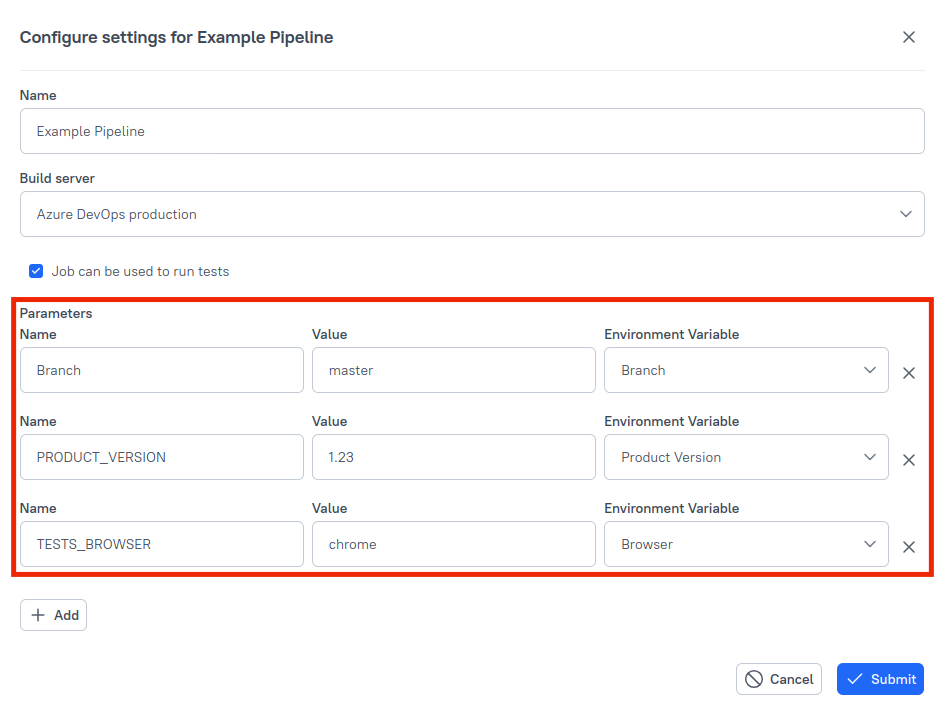
Click Submit.
3.4. Set the default values in pipeline
In Azure DevOps, go to Pipelines and select the pipeline you need.
In the top right corner, click Edit.
In the top right, click the Variables button.
For each parameter that you want to add, click + and fill in the fields:
- Name — the name of the environment variable (same as the Mapping key from step 3.2 and Name from step 3.3).
- Value — the default value that should be used unless overriden for a specific run (same as Value from step 3.3).
- Keep this value secret — must not be checked.
- Let users override this value when running this pipeline — must be checked.
Click OK to finish editing the new variable.
Click Save to apply the changes.